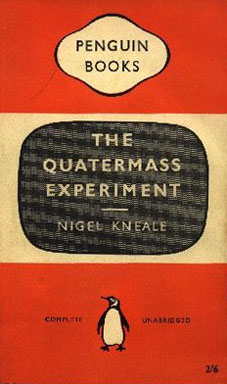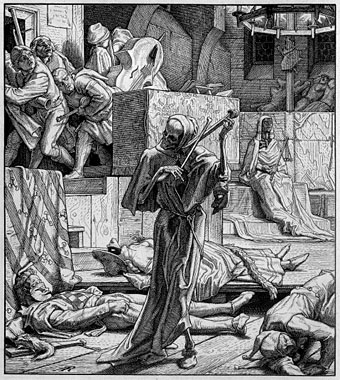
Nigel Kneale, creator of the Quatermass series, The Stone Tape and Beasts, died this week.
A journal by artist and designer John Coulthart.
Horror

Nigel Kneale, creator of the Quatermass series, The Stone Tape and Beasts, died this week.

Der Tod als Erwürger (1851) by Alfred Rethel.
It’s a fact (sad or otherwise) that a substantial percentage of my music collection would make good Halloween listening but in that percentage a number of works are prominent as spooky favourites. So here’s another list to add to those already clogging the world’s servers, in no particular order:
Theme from Halloween (1978) by John Carpenter & Alan Howarth.
What a surprise… All John Carpenter‘s early films have electronic scores and great themes, Halloween being the most memorable, and one that’s gradually infected the wider musical culture as various hip hop borrowings and Heat Miser by Massive Attack demonstrate.
Monster Mash (1962) by Bobby “Boris” Pickett.
The ultimate Halloween novelty record. A host of imitators followed the success of this single while poor Bobby struggled to be more than a one-hit wonder. It wasn’t to be, this was his finest hour. Available on These Ghoulish Things: Horror Hits for Halloween with some radio spots by Bobby and a selection of other horror-themed rock’n’roll songs.
The Divine Punishment (1986) & Saint of the Pit (1988) by Diamanda Galás.
Parts 1 & 2 of Galás’s Masque of the Red Death, a “plague mass” trilogy based on the AIDS epidemic. These remain my favourite records by Ms Galás; on the first she reads/sings passages from the Old Testament accompanied by sinister keyboards, making the Bible sound as steeped in evil and metaphysical dread as the Necronomicon. On Saint of the Pit she turns her attention to French poets of the 19th century (Baudelaire, Gérard de Nerval & Tristan Corbière) while unleashing the full power of her operatic vocalizations. Einstürzende Neubauten’s FM Einheit adds some thundering drums. “Correct playback possible at maximum volume only.” Amen to that.
The Visitation (1969) by White Noise.
An electronic collage piece about a ghostly lover returning to his grieving girlfriend. White Noise were David Vorhaus working alongside BBC Radiophonic Workshop pioneers Delia Derbyshire and Brian Hodgson to create an early work of British electronica and dark psychedelia. The Visitation makes full use of Derbyshire and Hodgson’s inventive tape effects and probably accounts for them being asked to score The Legend of Hell House a few years later. Immediately following this is the drums and screams piece, Electric Storm In Hell; play this loud and watch the blood drain from the faces of your Halloween guests.
Zeit (1972) by Tangerine Dream.
Subtitled “A largo in four movements”, Zeit is Tangerine Dream’s most subtle and restrained album, four long tracks of droning atmospherics.
The Masque of the Red Death (1997) read by Gabriel Byrne.
From Closed On Account Of Rabies, a Poe-themed anthology arranged by Hal Willner. The readings are of variable quality; Christopher Walken’s The Raven is effective (although I prefer Willem Defoe’s amended version on Lou Reed’s The Raven) while Dr John reads Berenice like one of Poe’s somnambulists. Gabriel Byrne shows how these things should be done.
De Natura Sonoris no. 2 (1971) by Krzysztof Penderecki.
More familiar to people as “music from The Shining“, this piece, along with much of the Polish composer‘s early work, really does sound like music in search of a horror film. His cheerily-titled Threnody For The Victims Of Hiroshima is one piece that won’t be used to sell cars any time soon. Kubrick also used Penderecki’s equally chilling The Dream of Jacob for The Shining score, together with pieces by Ligeti and Bartók.
Treetop Drive (1994) by Deathprod.
Helge Sten is a Norwegian electronic experimentalist whose solo work is released under the Deathprod name. “Electronic” these days often means using laptops and the latest keyboard and sampling equipment. Deathprod music is created on old equipment which renders its provenance opaque leaving the listener to concentrate on the sounds rather than be troubled by how they might have been created. The noises on the deceptively-titled Treetop Drive are a disturbing series of slow loops with squalling chords, anguished shrieks and some massive foghorn rumble that seems to emanate from the depths of Davy Jones’ Locker. Play it in the dark and feel the world ending.
Ouroborindra (2005) by Eric Zann.
Another collection of sinister electronica from the Ghost Box label (see this earlier post), referencing HP Lovecraft and Arthur Machen’s masterpiece, The White People. Spectral presences haunting the margins of the radio spectrum.
Theme from The Addams Family (1964) by Vic Mizzy.
Never the Munsters, always the Addams Family! If you don’t know the difference, you must be dead.
Happy Halloween!
Previously on { feuilleton }
• The music of the Wicker Man
Mrs Amworth.
Another great artist of the macabre and supernatural, Virgil Finlay was the one of the most talented and imaginative illustrators of his generation. Unlike older contemporaries such as Joseph Leyendecker, who became wealthy producing elegant yet often bland advertising art, much of Finlay’s best work was for pulp magazines like Weird Tales and Amazing Stories which paid a pittance and printed his finely-hatched scratchboard drawings on the cheapest paper. The advantages to this work, such as they were, came in the access to a huge and appreciative audience, and the chance to provide the first illustrations for what would turn out to be classic genre stories. Finlay illustrated a number of HP Lovecraft’s tales and received the highest praise from the author in doing so. His illustration for Lovecraft’s The Thing on the Doorstep (below) contains a slight nod to Harry Clarke’s Valdemar picture (see previous post) with its distant, highlighted doorway, a detail that Clarke himself borrowed from the celebrated Las Meninas by Velázquez.
Therionweb has five galleries of Finlay’s pictures and Bud Plant again has a brief biography.
Abercrombie Station.
The Thing on the Doorstep.
Six and Ten.
Elsewhere on { feuilleton }
• The illustrators archive
The Masque of the Red Death.
Halloween approaches so let’s consider the finest illustrator of Edgar Allan Poe’s stories, Irish artist Harry Clarke. Aubrey Beardsley once declared “I am grotesque or I am nothing” yet even his grotesquery—which could be considerable—struggled to do justice to Poe. Clarke, the best of the post-Beardsley illustrators, found a perfect match in the Boston writer’s Tales of Mystery and Imagination, his edition being published by Harrap in 1919. He could decorate fairy tales with the best of the great Edwardian book illustrators but a flair for the morbid blossomed when he found Poe. Only his later masterpiece, Goethe’s Faust, improved on the dark splendour of these drawings. “Never before have these marvellous tales been visually interpreted with such flesh-creeping, brain-tainting illusions of horror, terror and the unspeakable” wrote a critic in The Studio.
Lots more pictures at Grandma’s Graphics (although none of the colour plates, unfortunately) including many of the Faust drawings. Wikipedia has photos of some of Clarke’s incredible stained-glass windows, as does Bud Plant’s biography page.
Ligeia.
The Facts in the Case of M. Valdemar.
Elsewhere on { feuilleton }
• The illustrators archive

Q: What do you get when you cross analogue synthesizers, samples from obscure public information films, the graphic design of Pelican Books, Arthur Machen, HP Lovecraft, Algernon Blackwood, CS Lewis, Hammer horror, the Wicker Man and the music from Oliver Postgate’s animated films for children?
A: the CD releases by artists on the Ghost Box label. Ghost Box describe themselves as “an independent music label for artists that find inspiration in library music albums, folklore, vintage electronics, and the school music room” which, if you’re familiar with the reference points, is exactly what you get. A rather wonderful blend it is too, some of the tracks on Belbury Poly’s The Willows (named after Algernon Blackwood’s stunning horror tale) are how I expected Stereolab to sound until I heard them and was rather disappointed.
Favourite of the Ghost Box releases I’ve heard to date is (perhaps inevitably) Ourobourindra by Eric Zann (the “artist” here is named after Lovecraft’s haunted musician from The Music of Erich Zann). The website description—”Eric Zann’s radios, oscillators and recordings conjure eldritch, echoing spaces and invoke the voices of the dead that whisper within them”—again is a pretty accurate summation of this atmospheric and sinister audio collage. “Sinister” is a term that can be applied to much of this music and the Ghost Box founders, Julian House and Jim Jupp, declare in a Wire feature this month that matters spectral are of particular concern, hence the label name. Ourobourindra works especially well in this regard, sounding like the product of someone working through a trauma caused by viewing the seance scene from Dracula AD 1972 at too young an age. This is one I’ll be playing on Halloween.
Ghost Box music can be purchased online here.
Elsewhere on { feuilleton }
• The album covers archive
Previously on { feuilleton }
• Penguin book covers
• The music of Igor Wakhévitch
• The music of the Wicker Man
• The Absolute Elsewhere